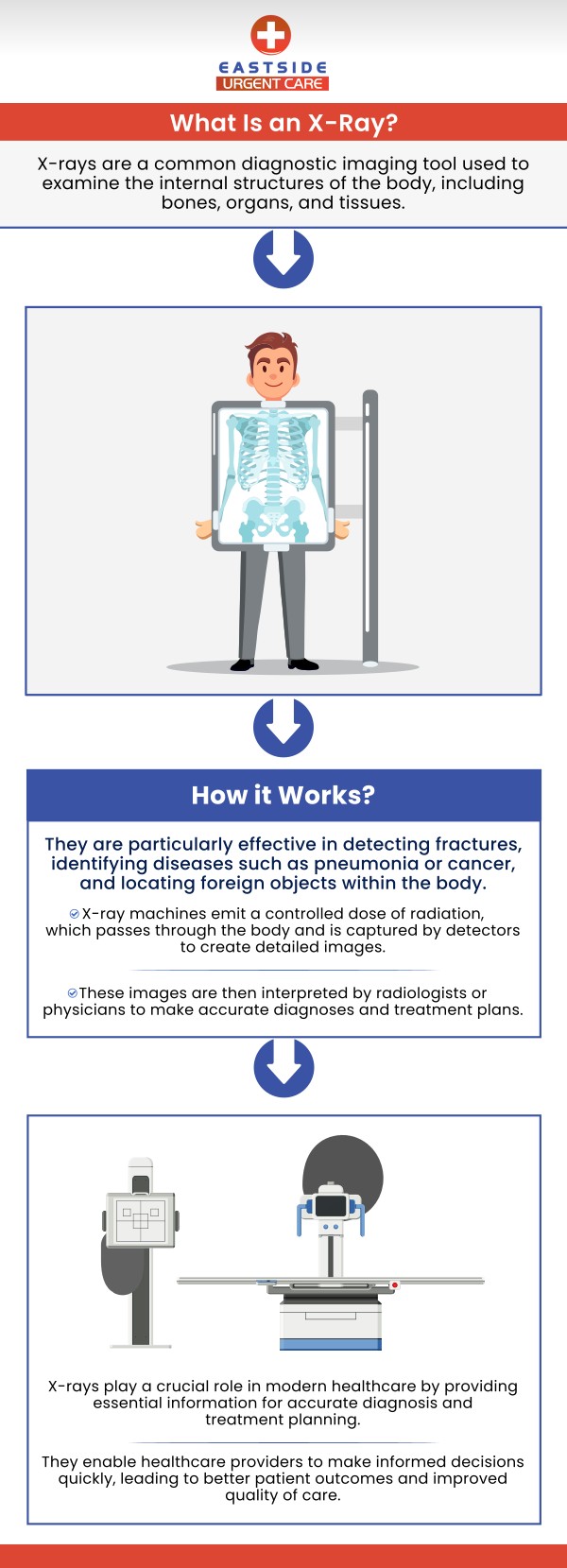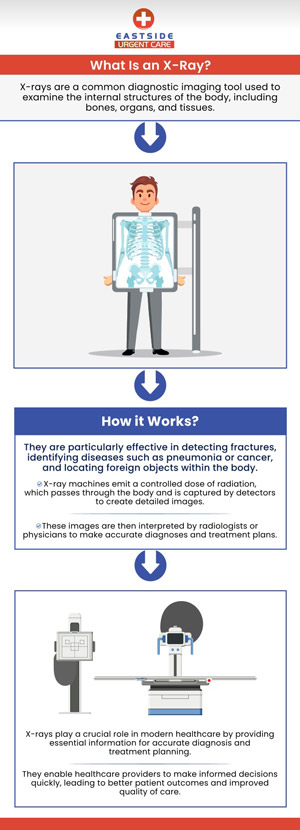On-site X-ray Services in Cincinnati, OH
On-site X-ray services provide immediate imaging capabilities, allowing for quick and accurate diagnosis of fractures, infections, and other medical conditions. This convenience eliminates the need for patients to travel to separate facilities, streamlining the diagnostic process and enabling faster treatment. Dr. Noor U. Hassan MD at Eastside Urgent Care offers on-site x-ray services. For more information, contact us or book an appointment. We are conveniently located at 872 Ohio Pike, Cincinnati, OH 45245.




Table of Contents:
When are imagining or x-rays commonly recommended?
What health conditions can be diagnosed with X-rays?
What is the difference between an MRI and an X-ray?
How much does an X-ray cost at an urgent care?
Imaging tests that are most common are X-rays, CT scans, and also MRIs, and ultrasounds in the below situations:
• Trauma or injury: Imaging tests are often used to diagnose and assess the severity of injuries, such as broken bones, head trauma, or internal organ damage.
• Chronic pain: Imaging tests can help identify the source of chronic pain, such as joint or bone disorders, and guide treatment.
• Cancer diagnosis and monitoring: Imaging tests like CT scans, MRIs, and PET scans are commonly used to diagnose and monitor cancer, as well as detect recurrences.
• Pre-surgical planning: Imaging tests help surgeons plan surgical procedures by showing some detailed images.
• Neurological disorders: Imaging tests like MRIs and CT scans are often used to diagnose and monitor conditions such as stroke, dementia, and multiple sclerosis.
• Infections: Imaging tests can help diagnose and monitor infections, such as abscesses, pneumonias, and sepsis.
• Chronic conditions: Imaging tests may be used to monitor chronic conditions like osteoporosis, arthritis, and inflammatory bowel disease.
• Surgical follow-up: Imaging tests are often used to monitor patients after surgery to ensure that the treatment was successful and to detect any potential complications.
In general, imaging tests are ordered when a healthcare provider suspects a specific condition or symptom based on patient symptoms, physical examination findings, and medical history. The type of imaging test used depends on the suspected condition and the individual patient’s needs.
X-rays are typically done to diagnose and keep a close eye on a large range of health concerns, including:
1-Bone fractures and bone diseases:
• Broken bones (fractures), such as wrist, ankle, or hip fractures
• Osteoporosis
• Osteopenia
• Bone tumors
2-Respiratory conditions:
• Pneumonia
• Pneumothorax (collapsed lung)
• Pleurisy (inflammation of the lining around the lungs)
• Bronchiectasis (chronic lung damage)
3-Gastrointestinal conditions:
• Gastroesophageal reflux disease (GERD)
• Intussusception (one part of the intestine telescopes into the other)
4-Musculoskeletal conditions:
• Osteoarthritis
• Rheumatoid arthritis
• Tendonitis
• Bursitis
5-Infections:
• Abscesses (pockets of pus)
• Osteomyelitis (infection of the bone)
6-Cancer:
• Bone cancer (e.g., osteosarcoma)
• Lung cancer
7-Other conditions:
• Cervical spine injuries or degenerative conditions
• Spinal fractures or compression fractures
• Hip or knee joint degeneration
Keep in mind that X-rays are not always the first line of diagnosis for these conditions. Your healthcare provider may order other imaging tests or physical exams to confirm a diagnosis. Additionally, X-rays may not always detect certain conditions, such as soft tissue injuries or internal organ damage.
The main difference between an MRI (Magnetic Resonance Imaging) and an X-ray is the type of energy used to produce the images:
• X-rays use ionizing radiation (X-rays) to produce images of internal features.
• MRI, which is done with strong magnetic fields and radio waves to align and manipulate the body’s hydrogen atoms, creating detailed images of internal structures, such as organs, soft tissues, and joints.
In general:
• X-rays are better suited for detecting bone density and density changes, making them useful for diagnosing conditions like osteoporosis, bone fractures, and joint problems.
• MRI is better suited for detecting soft tissue damage, inflammation, and internal organ damage, making it useful for diagnosing conditions like musculoskeletal disorders, stroke, and certain types of cancer.
Other key differences:
• X-rays are generally faster and less expensive than MRI scans.
• MRI scans require the patient to be positioned within a strong magnetic field, which can be claustrophobic or uncomfortable for some individuals.
• MRI scans may not be suitable for people with metal implants or certain medical devices.
• X-rays do not require any special preparation or equipment, making them more accessible.
In summary, while both X-rays and MRI scans are valuable diagnostic tools, they serve different purposes and are suited for different types of conditions.
The cost of an X-ray at an urgent care facility can usually range anywhere from $100-$300, based on the exact X-ray type and your insurance coverage. Here are some estimated costs:
• Basic chest X-ray: $100-$150
• Extremity X-ray: $150-$250
• Head or neck X-ray: $250-$400
Just remember, these are just estimates, and the actual costs may be different. Always talk to your insurance company and the urgent care center for a more accurate estimate. For more information, contact us or book an appointment. We are conveniently located at 872 Ohio Pike Cincinnati, OH 45245. We serve patients from Cincinnati OH, Covedale OH, Delhi OH, St Bernard OH, Wilders KY, and Elmwood Place OH.

Additional Services You May Need
▸ Asthma
▸ Bronchitis
▸ DOT Physical
▸ Employment Drug Screen
▸ Illness
▸ Injury
▸ Insect and Animal Bites
▸ Occupational Medicine
▸ Pediatric Visit
▸ Pre-OP Physical
▸ School & Sports Physicals
▸ STD And Treatment
▸ Rash/Allergic Reaction
▸ Stomach Flu Treatment

Additional Services You May Need
▸ Asthma
▸ Bronchitis
▸ DOT Physical
▸ Employment Drug Screen
▸ Illness
▸ Injury
▸ Insect and Animal Bites
▸ Occupational Medicine
▸ Pediatric Visit
▸ Pre-OP Physical
▸ School & Sports Physicals
▸ STD And Treatment
▸ Rash/Allergic Reaction
▸ Stomach Flu Treatment



